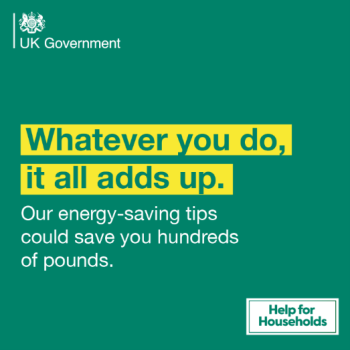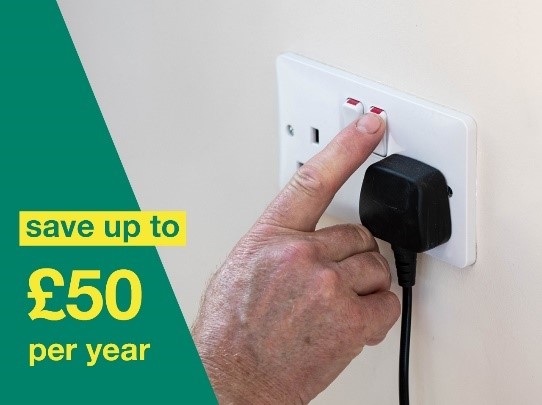Case Study Overview
The campaign “It all adds up” was launched in response to an increase in consumer demand for more information and increased impartial information on energy saving options, which was itself triggered by rising energy bills and a cost-of-living crisis. The campaign ran from December 2022 until March 2023.

Design
Target audience: The campaign was generally targeted at individual energy consumers living throughout the United Kingdom, with a particular focus on vulnerable low-income households facing fuel poverty.
Objectives and message: The campaign aimed to contribute to a number of UK government objectives including reducing energy consumption by 15% by 2030 when compared to 2021 consumption levels; reducing the burden of financial support schemes offered by the government; and supporting households to reduce their energy bills. Specific communication objectives of the campaign were to increase consumers capability to reduce their own household energy consumption, and therefore bill, through the most effective actions. Secondary objectives included ensuring an adequate energy supply over the heating season by reducing overall energy demand and driving the take-up of energy efficiency measures, including longer term measures to prepare homes for the next winter. Lastly, the campaign aimed to provide vulnerable households with the right information to reduce their energy usage without harming their health.
The tagline “It all adds up” was chosen to reflect the objectives and reinforce the idea that quick and easy energy-saving actions can add up to significant savings in households’ energy consumption. The accompanying messaging was anchored in cost saving, which was determined as the primary motivator for saving energy amongst the public.
Resources: In terms of personnel dedicated to the campaign, three policy advisors developed and provided advice for the campaign, and four members of the communications team were fully dedicated to the planning, development, and delivery of the paid advertising campaign. Colleagues from the press, stakeholder engagement, and digital teams also contributed throughout the campaign.
The most important lessons learned: The key lesson learnt was that longer planning time would have had positive impacts across every area of the campaign. This includes, for instance, enabling the campaign to use more media innovations, securing the best-case studies and celebrity talent for media partnerships, or securing the most appropriate influencers to work with. While paid partnerships were one of the strongest performing channels, again here a longer lead time would have been beneficial, and it is recommended to book these partnerships in advance to allow for more time to deepen the impact of this channel.
Implementation
Media channels used:  The campaign revolved around behavioural change related to the cost of living. Research found that to create tangible behaviour change and overcome efficacy barriers it was best to communicate small and easy actions. This led to three specific actions. (1) Visually, the ‘Help for Households’ branding helped increase campaign recognition and ensure alignment with cross-government campaigns. (2) The tagline “It All Adds Up” was used as it was simple, clear and related to monetary savings. (3) A mixture of mass media promotion channels was used to create awareness, inform and educate, and to promote action. This included TV, Radio, out of home (OOH) billboards and posters and video on demand platforms (VOD), followed by print media, display, and partnerships. Significant investment was made in media partnerships and community channels aimed at reaching more vulnerable audiences effectively. The campaign tested several media innovations including a Snap Chat Lens, conversational ads with contextual overlay, and brand lift studies.
The campaign revolved around behavioural change related to the cost of living. Research found that to create tangible behaviour change and overcome efficacy barriers it was best to communicate small and easy actions. This led to three specific actions. (1) Visually, the ‘Help for Households’ branding helped increase campaign recognition and ensure alignment with cross-government campaigns. (2) The tagline “It All Adds Up” was used as it was simple, clear and related to monetary savings. (3) A mixture of mass media promotion channels was used to create awareness, inform and educate, and to promote action. This included TV, Radio, out of home (OOH) billboards and posters and video on demand platforms (VOD), followed by print media, display, and partnerships. Significant investment was made in media partnerships and community channels aimed at reaching more vulnerable audiences effectively. The campaign tested several media innovations including a Snap Chat Lens, conversational ads with contextual overlay, and brand lift studies. 
Recommended measures: The recommended measures used were on evidence from extensive research, and identified actions, which consumers may not be aware of, that could reduce energy bills without minimising their level of comfort. A list of almost twenty actions was put together and divided into three categories: (1) free ways to save energy (e.g. adjust boiler-flow temperature), (2) low-cost home improvements (e.g. draught proofing) (3) spend-to-save improvements (e.g. insulation). The campaign centred around key behaviours that were simple, safe and impactful, such as:
- Reduce boiler flow temperature,
- Turn down radiators in rooms not in use,
- Find and fix draughts.
 Stakeholder involvement: Cooperation was mainly formed with media and community partners, particularly to reach more vulnerable households. For instance, partnerships with Bauer Media Group and The Telegraph newspaper group facilitated reaching certain audiences – and demonstrated a demand for in-depth articles that explain more complex measures. Community partnerships helped deliver language-specific versions of content to increase effectiveness with diverse audiences.
Stakeholder involvement: Cooperation was mainly formed with media and community partners, particularly to reach more vulnerable households. For instance, partnerships with Bauer Media Group and The Telegraph newspaper group facilitated reaching certain audiences – and demonstrated a demand for in-depth articles that explain more complex measures. Community partnerships helped deliver language-specific versions of content to increase effectiveness with diverse audiences.
The most important lessons learned: The most important lesson learned from the campaign was that for more complex actions to be adopted, greater explanation, guidance and reasons to believe need to be supplied. Longer-form content can help with this. Tailoring messages to younger age groups can also help achieve greater cut-through. A recommendation for the next campaign, it to keep the media strategy of buying an all-adult audience with upweights towards vulnerable audiences where possible is recommended.
Tracking
Impacts: The goal was to increase visits to the campaign website and increase uptake of recommended actions. Impacts on behaviour, understanding and action the public had taken were evaluated over the course of the awareness campaign. It was found that awareness of the priority campaign actions had increased.
By the end of the campaign, 57% of those surveyed had heard publicity around the topic of reducing energy use and 71% recognised at least one element of the campaign (Source: Internal Campaign Tracking Survey). In the period from December 27 to March 31, there were 787.3 thousand visits to the campaign website. Internal analysis showed that the campaign resulted in a significant return on investment for UK households and the UK treasury.
![]() Outcomes: The campaign contributed towards an overarching departmental objective of reducing energy consumption by 15% by 2030. The campaign was successful in changing behaviours, surpassing the predetermined KPI’s. Post campaign launch, the number of UK adults who had taken at least one of the three recommended actions increased significantly. Advice on reducing boiler flow temperatures was particularly successful, with analysis of real-world boiler data showing a doubling of the number of households who reduced their boiler flow temperature to exactly 60 Celsius in 2022-23, compared to the previous winter [Link to preliminary findings of boiler flow temperature study].
Outcomes: The campaign contributed towards an overarching departmental objective of reducing energy consumption by 15% by 2030. The campaign was successful in changing behaviours, surpassing the predetermined KPI’s. Post campaign launch, the number of UK adults who had taken at least one of the three recommended actions increased significantly. Advice on reducing boiler flow temperatures was particularly successful, with analysis of real-world boiler data showing a doubling of the number of households who reduced their boiler flow temperature to exactly 60 Celsius in 2022-23, compared to the previous winter [Link to preliminary findings of boiler flow temperature study].
The most important lessons learned: A collaborative approach was essential throughout the campaign. For example, the campaign team worked with the centrally led cross government Help For Households campaign to avoid duplication and ensure frequency of messaging. Collaborative work with consumer advice organisations and research companies (e.g. through set up of a working group) facilitated the sharing of best practice and reduced the possibility of conflicting messages on energy saving for consumers. Additionally, it was found that delivering out of home (OHH) messaging earlier to ensure that the campaign can deliver more support and advice to people in vulnerable areas was a key learning from the campaign.
Campaign Summary
| Agency | Department for Energy Security and Net Zero |
| Slogan | “It all adds up” |
| Website | https://helpforhouseholds.campaign.gov.uk/energy-saving-advice |
| Contact person | Molly Connors (molly.connors@energysecurity.gov.uk) |

